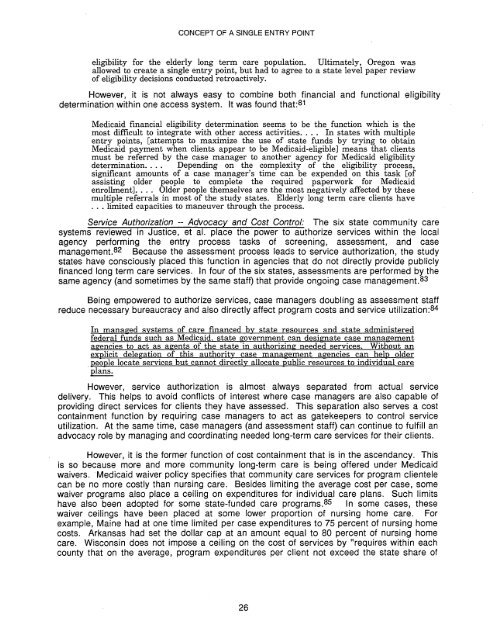long-term care - Legislative Reference Bureau
long-term care - Legislative Reference Bureau
long-term care - Legislative Reference Bureau
You also want an ePaper? Increase the reach of your titles
YUMPU automatically turns print PDFs into web optimized ePapers that Google loves.
CONCEPT OF A SINGLE ENTRY POINT<br />
eligibility for the elderly <strong>long</strong> <strong>term</strong> <strong>care</strong> population. Ultimately, Oregon was<br />
allowed to create a single entry point, but had to agree to a state level paper review<br />
of eligibility decisions conducted retroactively.<br />
However, it is not always easy to combine both financial and functional eligibility<br />
de<strong>term</strong>inationwithin one access system. It was found that: 81<br />
Medicaid financial eligibility de<strong>term</strong>ination seems to be the function which is the<br />
most difficult to integrate with other access activities. . .. In states with mUltiple<br />
entry points, [attempts to maximize the use of state funds by trying to obtain<br />
Medicaid payment when clients appear to be Medicaid-eligible] means that clients<br />
must be referred by the case manager to another agency for Medicaid eligibility<br />
de<strong>term</strong>ination. . . . Depending on the complexity of the eligibility process,<br />
significant amounts of a case manager's time can be expended on this task [of<br />
assisting older people to complete the required paperwork for Medicaid<br />
enrollment]. . .. Older people themselves are the most negatively affected by these<br />
multiple referrals in most of the study states. Elderly <strong>long</strong> <strong>term</strong> <strong>care</strong> clients have<br />
... limited capacities to maneuver through the process.<br />
Service Authorization -- Advocacy and Cost Control: The six state community <strong>care</strong><br />
systems reviewed in Justice, et al. place the power to authorize services within the local<br />
agency performing the entry process tasks of screening, assessment, and case<br />
management. 82 Because the assessment process leads to service authorization, the study<br />
states have consciously placed this function in agencies that do not directly provide publicly<br />
financed <strong>long</strong> <strong>term</strong> <strong>care</strong> services. In four of the six states, assessments are performed by the<br />
same agency (and sometimes by the same staff) that provide ongoing case management. 83<br />
Being empowered to authorize services, case managers doubling as assessment staff<br />
reduce necessary bureaucracy and also directly affect program costs and service utilization: 84<br />
In managed systems of <strong>care</strong> financed by state resources and state administered<br />
federal funds such as Medicaid. state government can designate case management<br />
agencies to act as agents of the state in authorizing needed services. Without an<br />
explicit delegation of this authority case management agencies can help older<br />
. people locate services but cannot directly allocate public resources to individual <strong>care</strong><br />
plans.<br />
However, service authorization is almost always separated from actual service<br />
delivery. This helps to avoid conflicts of interest where case managers are also capable of<br />
providing direct services for clients they haye assessed. This separation also serves a cost<br />
containment function by requiring case managers to act as gatekeepers to control service<br />
utilization. At the same time, case managers (and assessment staff) can continue to fulfill an<br />
advocacy role by managing and coordinating needed <strong>long</strong>-<strong>term</strong> <strong>care</strong> services for their clients.<br />
However, it is the former function of cost containment that is in the ascendancy. This<br />
is so because more and more community <strong>long</strong>-<strong>term</strong> <strong>care</strong> is being offered under Medicaid<br />
waivers .. Medicaid waiver policy specifies that community <strong>care</strong> services for program clientele<br />
can be no more costly than nursing <strong>care</strong>. Besides limiting the average cost per case, some<br />
waiver programs also place a ceiling on expenditures for individual <strong>care</strong> plans. Such limits<br />
have also been adopted for some state-funded <strong>care</strong> programs. 85 In some cases, these<br />
waiver ceilings have been placed at some lower proportion of nursing home <strong>care</strong>. For<br />
example, Maine had at one time limited per case expenditures to 75 percent of nursing home<br />
costs. Arkansas had set the dollar cap at an amount equal to 80 percent of nursing home<br />
<strong>care</strong>. Wisconsin does not impose a ceiling on the cost of services by "requires within each<br />
county that on the average, program expenditures per client not exceed the state share of<br />
26
















